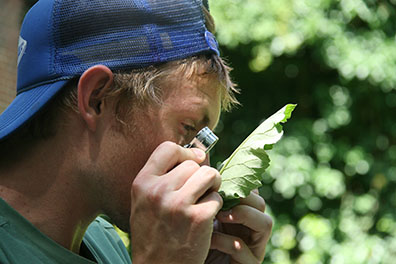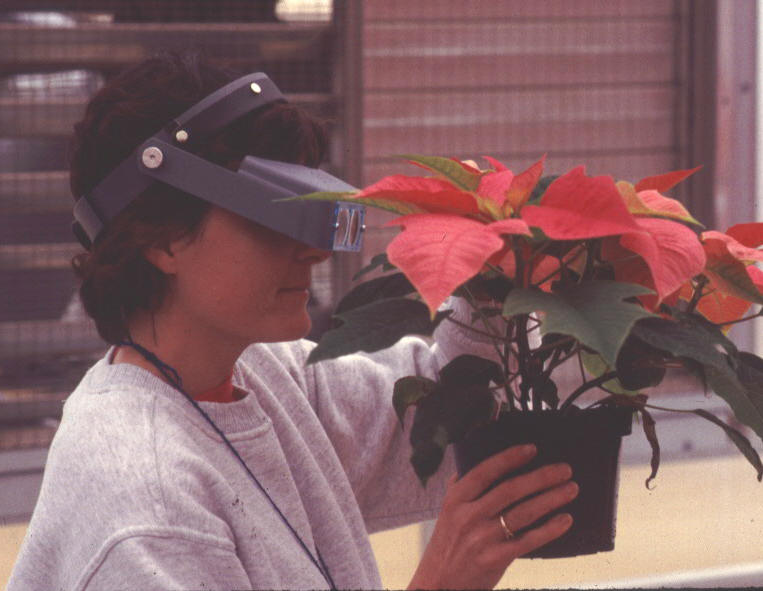Hand lenses are small inexpensive optical devices that are easy to carry on a lanyard or folded up in a pocket. Most of them magnify 5 to 20 times. The correct way to use one is to hold it so that the lens is an inch or so in front of your eye. This is an important point. Holding the lens far from your eye barely works…just barely. Also, the field of view is severely restricted if you hold the lens far from your eye.
I rest the hand holding the lens against my cheek bone, to ensure it stays close, and at a constant distance. Then, with my other hand holding the specimen, I bring the subject up to the lens. I usually touch my two hands together once I’ve found the correct distance between lens and subject. That keeps it there, at the correct distance. In most cases, the specimen will be in focus if it is one to three inches from the lens. Hold it parallel to the surface you’re examining. If you hold your head down to do these things, you’ll be shading the subject, so it is usually better to hold the subject up, and turn so the light illuminates the subject. A hat or long hair can also shade things, so you may wish to remove or reverse your cap and tie up loose hair. I usually recommend buying a lens with no more than 10x magnification. The reason is that higher magnification creates a shorter focal distance, making it much harder to use the lens. Also, high magnification means a very small field of view. I like lenses that are relatively large… ¾ inch or so is about the biggest hand lens you’ll find. Tiny ones are really difficult to use. Most hand lenses are built so that they fold up when not in use, to protect the lens surface from scratches. I use 10X lenses to look at small things… look at buds on trees, identify mites and aphids, look for small details on insects.

Mangifiers are usually larger than hand lenses. They usually offer magnification in the 2x to 8x range. The larger lens size means you have a much larger field of view, compared to using a hand lens. I especially like the large rectangular ones…with lenses about 4inches long. That gives you the opportunity to use both eyes if you wish. I find it much more useful to hold the magnifier relatively close to my eye, compared to holding it far away. If you hold it far away from your eyes, and have the subject only an inch or two below the magnifier, you’ll get almost zero magnification! [In other words… don’t do that!]
Some magnifiers have a long handle, and do not fold up. That means it can be convenient to put one in your pocket, with the handle sticking out. That’s quick and convenient, but be sure nothing else hard is in your pocket, or you’ll scratch the lens surface. That’s a common way to ruin one, especially if it has a plastic lens. A few magnifiers offer battery powered lights attached to them. Some folding pocket magnifiers have two or three large diameter (1.5 inches) lenses. By stacking one lens over the other, you increase magnification, but you also increase the possibility that dirt or scratches will mar the view. I like them, even though they are a bit expensive. I use 2x two by four inch rectangular magnifiers (with a small 4x insert lens built in) to count insects on sticky cards, look at apple maggot traps, examine blueberry fruit fly traps and other tasks. When not in use, mine usually stay in their cases. The folding pocket magnifiers get folded up and placed in a pocket. They’re so expensive, I usually place mine in a pocket that has a button or zipper to close it. That way, it won’t fall out of my shirt pocket when I lean over.
Head-mounted lenses have various brand names (optivisor is one), and offer the ability to magnify your view, while keeping both hands free. Most offer 5x to 10x magnification, but some go higher. When using the lenses, you flip them down in front of your eyes. When done, you flip them up. It takes a little practice to use them without getting dizzy. The trick is to always flip them up (or look down, not through the lens) when you walk to the next plant. If you try walking while looking through the lenses, you’ll quickly realize that the only things in focus are those 3 to 5 inches in front of your eyes! That makes you dizzy quickly. I use a head mounted lens when I need to have both hands free. In greenhouse scouting, that lets me pick up a pot with one hand, and turn a plant leaf over with the other. Sometimes I use one in small engine repair or maintenance, for the same reason.

Microscopes - Once I’m back in my office, a microscope is my main aid to examine small things. If you are considering purchasing a microscope, try it first, before buying. A good one can be very expensive… $800 to $5000. For insect identification and similar tasks, a “dissecting” microscope is the preferred type. That means you are usually lighting the subject from above, and the light bounces off the subject and enters the lenses. Usually that type doesn’t offer high magnification. Don’t get a transmission microscope unless you plan on looking at microbes or thin sections of material. That type requires that you mount a subject on a clear glass slide, then shoot light from below through the slide and specimen, into the lenses. High magnification sounds impressive to a novice user, but what we really want is high resolution (sharpness). Unless you expect to do a LOT of microscope work, buying one may not be a wise investment. They need to be protected from moisture and dust, and shouldn’t be dropped. By the way, for most dissecting microscopes, you’ll also have to buy an illuminator.
Cost - Basically, you get what you pay for. You can get a cheap hand lens for as little as $4, but the ones I like typically cost $12 or so. Glass lenses are usually more expensive than plastic ones (and they’re less easily scratched). Some lenses are constructed to avoid chromatic aberration (colored lines at the edges), and tend to be more expensive. Magnifiers go for $10 to $40, depending on whether or not they have a built-in light, or if they have multiple lenses. Head-mounted magnifiers go for $40 to $80, depending on the complexity of the options you want.
Glasses on? Glasses Off? Generally, you use these visual aids with your glasses on, but some people find it easier to use with glasses off. My advice: try them both ways, and see what works best for you.
Where to find them - Some pest management supply companies have an assortment of visual aids (Great Lakes IPM and Gemplers, for example). You can also find them at science supply companies, educational supply stores, hobby stores, and sometimes drug stores. Some companies on line (ultraoptix for example) specialize in magnifiers, but usually they have a relatively large minimum order size. For a while, the bookstore at UNH had some, so other universities might do the same, especially if they teach courses in dendrology, plant identification, or entomology.
Download the Resource for the complete fact sheet and a printable version.


